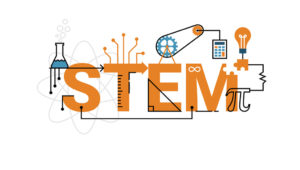Finding a passion in STEM
While many young adults struggle to stay interested in STEM fields, they all recognize STEM’s importance to their futures
May 4, 2018
STEM – Science, technology, engineering and math. Called by some the next common core teaching standard, while called by others the future of innovation and careers. Despite the popularity of STEM and the integration of it into other aspects of academics, such as art and even religion, giving way to STEAM/STREAM schools, it appears that many students are struggling nationwide to keep an interest in the STEM initiative. Why, in an age where technology is at the fingertips of nearly every citizen in a developed country and the future shows a solid path of careers oriented towards science and engineering, is STEM losing footing within the younger generation?
According to data from Penn Course Review obtained from The Daily Pennsylvanian, “students rate STEM departments consistently lower than non-STEM departments in several categories. Across a number of departments, ranging from math to biochemistry to systems engineering, students report learning less, an increased level of difficulty and work required, and lower instructor quality. And they’re dramatically less likely to recommend courses from STEM departments to non-majors”.
This national trend holds true at Bishop Noll, too. According to a survey of 77 students at Bishop Noll, STEM initiatives, while they are good in concept, do not necessarily transfer well when it comes to their ability to be applicable to all students. But that doesn’t mean Noll students aren’t open to STEM ideas. Seventy-percent of those students believe that pushing a STEM/STREAM curriculum is a good idea; it just needs to include more pathways.
“While the program itself would be potentially helpful in modern adult life, the courses offered do not seem to live up to the program’s promises,” said junior John Wea.
Despite the fact that some students may feel as such, junior Athena Rojas believes the contrary.
“I personally am [interested] because our society is constantly growing and becoming more technology based. If one person can create an item or find solutions to long-standing problems that we’re facing today, that’s pretty amazing,” Rojas said. “I think that’s what STEM is about. It’s so much problem solving, creation, and imagination, which seems to be lacking in our generation. Instead of going for such cookie-cutter jobs, STEM gives students freedom to explore and create products that the world has never seen”.
This year’s freshman class is more interested in STEM than previous classes were. Much of this could be due to Mrs. Mary Albrecht’s Design & Modeling class, where students design solutions for real-world problems. Just recently, they finished a project in conjunction with the theology department that designed a sustainable program for a country connected to Operation Rice Bowl.
“I am extremely interested in STEM, as well has STREAM, because it is a combination of skills and careers and hobbies that will benefit the future,” said freshman Olivia Baczkowski.
But despite the feel for the need of STEM education, students all over the country still want the STEM curriculum to broaden out. Fifty-five-percent of Bishop Noll students wish to see more STEM classes offered at Bishop Noll that could provide experience for future careers. In the survey, the overwhelming majority of STEM-related classes suggested were culinary arts or food sciences (78%), outdoor education/horticulture/agriculture (60%), music or sound engineering (59%) and graphic design (47%). Other suggested classes, such as auto mechanics and sewing, would serve to target basic life skills.
Although these areas seem like something of an anachronism, they are anything but. Today’s generation of young adults harken back to their grandparents’ day as a counter-reaction to the sped-up lifestyle of the 21st century. They yearn to know the skills that their parents didn’t teach them because they thought those skills would be replaced by technology.
This is largely exemplified through young people’s interests: they support pop-up shops, purchase products made locally, drop mixtapes, and look to enjoy sustainable lifestyles.
Some STEM schools are already taking advantage of this trend in Gen Z culture by integrating it into their STEM curriculum. Culinary arts as a STEM class might involve a chemical change lab during a recipe’s process or a project to invent a kitchen gadget. A New York restaurant, Brooklyn Kitchen, provides weekly seminars for STEM teachers to learn how to integrate STEM lessons into cooking. Locally, the Chicago High School for Agricultural Sciences offers a Food Science and Technology pathway as part of their STEM curriculum.
Although Noll doesn’t plan on going that far in its STEM curriculum, they are expanding the program next year to include three important pathways: Engineering, Computer Science, and BioMedical, according to Albrecht.
“ The Engineering Pathway plan is to offer the PLTW course Intro to Engineering Design next year, and then Principles of Engineering the following year,” Albrecht said. “Intro to Engineering Design is a fun class where students dig deep into the engineering design process applying stem standards to hands-on projects like designing a new toy or improving an existing product. In Principles of Engineering, students explore a broad range of engineering topics including mechanisms, strength of structure and materials, and automation including designing a self-powered car. We also have plans to have a 3D printer in the STEM room for next school year.”
While students are split on whether or not a traditional STEM curriculum is or is not effective in preparing them for a diverse range of careers, it appears that they can all agree on one thing: STEM classes teach vital skills for a technology-based future. However, there is also a disconnect whether or not it is beneficial for students to take STEM classes when they may not pursue a career in STEM. An unnerving statistic shows that the majority of high school students who intend to major in a STEM field in college won’t be able to handle the rigor of the science, technology, engineering, or math courses needed to obtain a degree. According to a 2015 survey done by the testing giant ACT, only 26-percent of high school seniors who expressed in interest in a STEM field are academically ready.
This could explain why many students are drawn to other fields.
“Some students excel more in the arts then they do in math or science. The arts should be pushed more as an option rather than an elective that means nothing,” said senior Josefina Cordova. While STEM classes are known to boast a largely male population, there have been and continue to be numerous initiatives to boost the enrollment of females into the courses, with even Yale University taking on this task by offering a class based on how factors such as gender, race, religion, sexuality and economic circumstances shape the STEM experience at Yale and nationwide, according to a Nov. 14 article in the Yale Daily News by Niki Anderson. A 2015 report done by Junior Achievement and Ernst & Young LLP reports that only 11-percent of girls between the ages of 13 and 17 intend to pursue a career in a STEM field. It is the hope that increase and inclusivity in STEM may gain it larger membership and larger numbers of groups that are interested.
Despite being unable to pinpoint the exact cause of disruption between STEM classes goals and their execution of said goals, it appears that one thing is certain – those with or without a STEM background or major are all striving for an ultimate goal, and, as The Daily Pennsylvanian stated, “Even though students are often pushed to study “useful” subjects like STEM to gain a competitive advantage in the job market…future earnings are never the sole motivation, especially for courses that demand so much time and energy”.
It appears that STEM, while it may be the future for careers and education, needs work to make it both accessible as well as interesting. For many students, the disconnect between STEM programs being helpful rather than a waste of time lies in the use of it, and with schools beginning to integrate the program into their curriculum, it appears that many have hope that the program may be renovated to better suit student needs.


